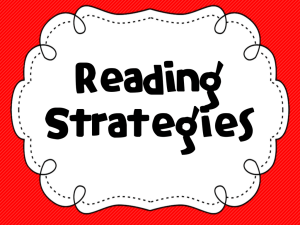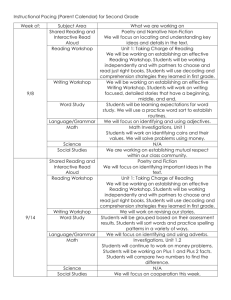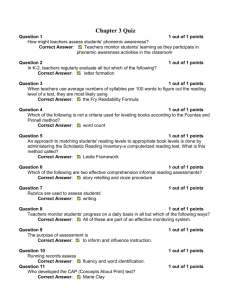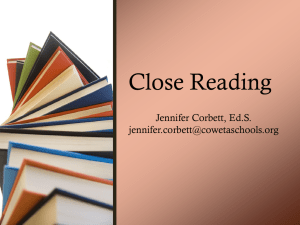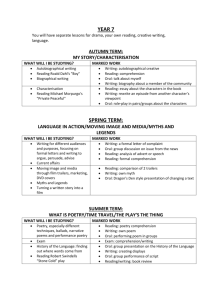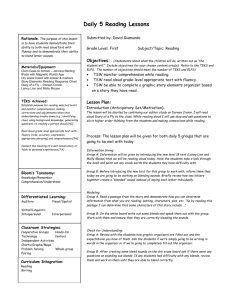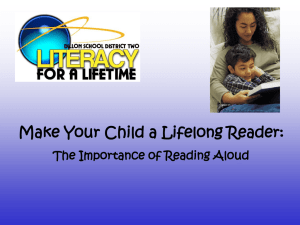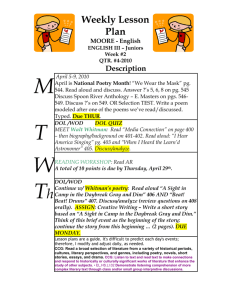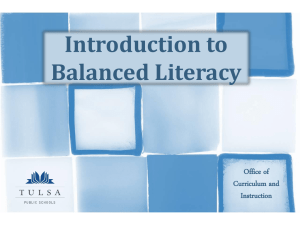Shared Reading
advertisement
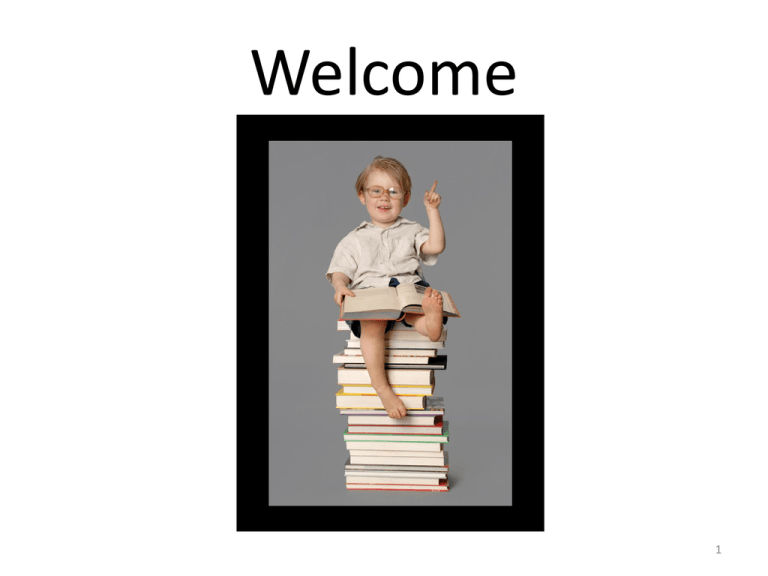
Welcome 1 Objectives • Watch “Shared Reading” video and reflect with groups • Define “Shared Reading” • Discuss the benefits of Shared Reading • Discuss helpful materials and resources • Discuss possible lesson ideas • Block Party : Pre-reading text based activity • Each person receives a quote. Think about what the quote means to you and Readers Workshop. • Mingle and share your quotes in pairs. Mingle and share with others. • Whole group share of ideas and questions Shared Reading “Shared Reading is a form of reading aloud to children with a dual focus. In addition to reading a good book for enjoyment and understanding, the teacher and children can read for teaching and learning literacy concepts and strategies.” - Parks (2002) What Does it Look Like--Shared Reading • In Shared Reading the text is enlarged using a big book, chart, or projected text so the text is visible to the students at all times. • Provides an opportunity for the teacher to demonstrate phrased, fluent reading and to draw attention to critical concepts about print • The text is selected to meet the needs of the students, enabling them to actively participate in the reading of the text. Reading about Shared Reading •Text Savvy Excerpt-everyone •Shared Reading in the Intermediate Grades(Group 1) •Shared Reading to Build Vocabulary and Comprehension Group 2 •Chalk Talk How Shared Reading Differs from Read Aloud Shared reading complements and extends interactive read aloud, but there is one critical difference--especially for the youngest learners. In shared reading, students can see the text. This allows the teacher to clearly and explicitly show what proficient readers do to meet the challenges of text. Why Shared Reading… • We know from Vygotsky, that children can do more and learn more with the support of a “more expert other” than they can do and learn by themselves. • During shared reading, learners observe an “expert” doing what s/he genuinely does (to make meaning) in the most authentic way (in the act of reading) and are encouraged to engage in the task. Benefits of Shared Reading 1. 2. 3. 4. Allows students to enjoy materials that they may not be able to read on their own. Ensures that all students feel successful by providing support to the entire group. Students act as though they are reading. Helps novice readers learn about the relationship between oral language and printed language. 5. Assists students in learning where to look and/or focus their attention. 6. Supports students as they gain awareness of symbols and print conventions, while constructing meaning from text read. 7. Assists students in making connections between background knowledge and new information. 8. Focuses on and helps develop concepts about print and phonemic connections. 9. Helps in teaching frequently used vocabulary. 10. Encourages prediction in reading. 11. Helps students develop a sense of story and increases comprehension. http://www.prel.org/toolkit/pdf/teach/Shared%20Reading.pdf General design for a Shared Reading lesson • Generally begins with rereading of something familiar • Then a new text is introduced or another reading is revisited for in-depth rereading and discussion • Finally there is an explicit mini-lesson either preplanned based on previous in-depth reading or as a result of that day’s lesson What did you… Watch the Video How does Shared Reading fit in? I Do, You Watch – Demonstration The fluent reading on the first entry into the text Think aloud by the teacher I Do, You Help - Shared Demonstration Students participate in the reading, practicing the strategy with the teacher Response by students – post its, etc. I Do, You Do—Students apply what they learned or work with partner Elementary Grades Shared Reading Video • What techniques did the teacher use to encourage student involvement during the reading process? • What materials were useful during the lesson? • How did the shared reading lesson exemplify “purposeful instruction”? • How did the teacher select the text that would be used during the shared reading lesson Subsequent Readings “The repeated readings of the same story serve various purposes. The first reading is for enjoyment; the second may focus on building and extending comprehension of the selection; a third might focus attention on the interesting language and vocabulary; a fourth might focus on decoding, using the words in the selection as a starting point for teaching word identification skills” (Yaden, 1989). Student Involvement During Shared Reading • • • • • • • “Turn and Talk” Mouth the words You read, I read Cloze reading Choral reading Dramatization Read to yourself then read along Shared Reading Upper Elementary Grades • Video • Shared Reading and Annotation Shared Reading Lesson Overview Summer of the Shark Text Summer of the Shark Lesson Plan Immigrant Kids Immigrant Kids Planner Oak and Rose Oak and Rose Planner Follow along with the lesson plan • “What We Eat” Lesson Ideas Word Decoding Concepts of Print • Letter-sound relationships • Blends • Onsets/Rhymes • Following a word through • High frequency words • Spelling/Sound patterns • Word sorts • Prefixes/Suffixes • Context clues • Inflected endings Etc… • Title, author, illustrator • Text features (index, glossary, table of contents, etc.) • Headings/Subheadings • Captions • Spacing • Pictures • One-to-one correspondence • Directionality • Punctuation • Letters, words, sentences Etc… Shared Reading Resources • Student Textbooks • Content reading • Trade books • Magazines (article copied) • Newspaper article • Time For Kids • Big books • Poetry Resources • Toolkit Lesson Ideas Comprehension • Main idea • Comparing/Contrasting • Theme • Cause and effect • Summarizing • Sequencing • Conflict • Point of View • Drawing conclusions • Inferring Etc… Reading Strategies • • • • • • • • • • • • • Rereading Confirming Searching for information Self-monitoring Making meaning Reading with expression, fluency, and phrasing Cross-checking Making connections/Schema Questioning Visualizing Inferring Determining Importance Synthesizing Etc… Lesson Ideas Author’s Craft Genre • Vocabulary • Figurative language • Sentence structure • Dialogue • Point of View • Text structures Etc… • Fables • Tall tales • Folktales • Fiction • Nonfiction • Fantasy • Poetry Etc… Lesson Ideas Your Turn Author’s Craft Genre • Vocabulary • Figurative language • Sentence structure • Dialogue • Point of View • Text structures Etc… • Fables • Tall tales • Folktales • Fiction • Nonfiction • Fantasy • Poetry Etc… Why We Love Teachers Video In This Moment song The toughest job Exit slip Shared reading is like ____because______.

